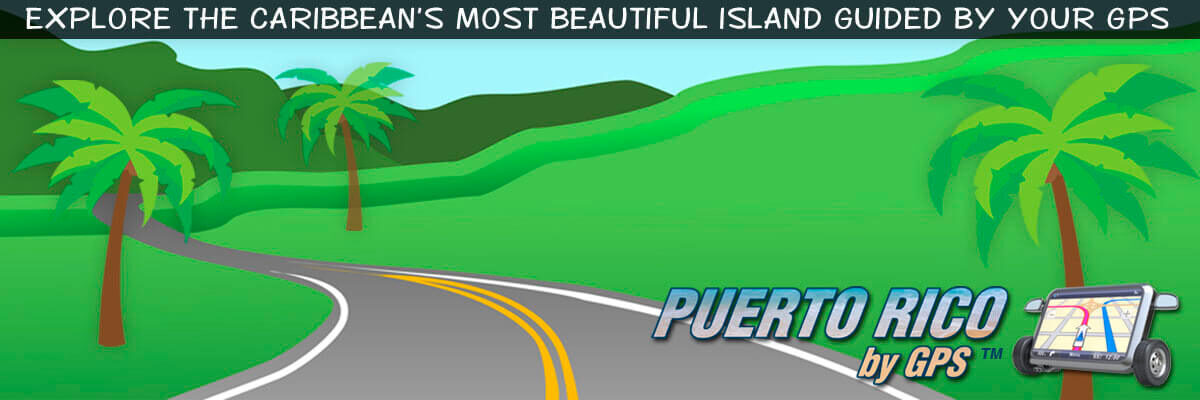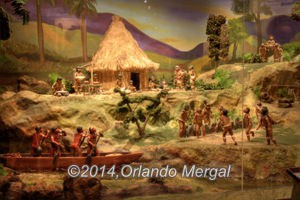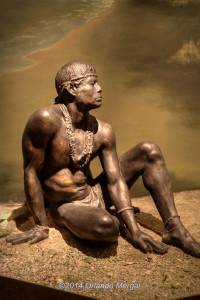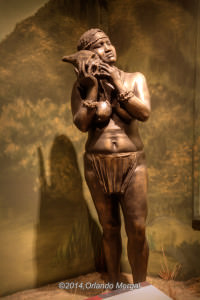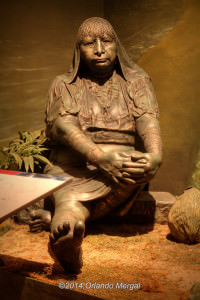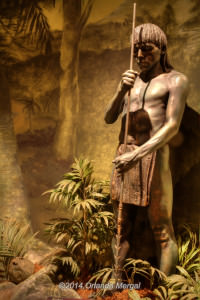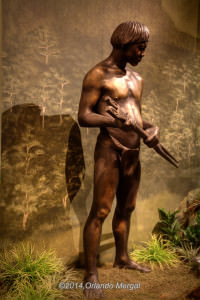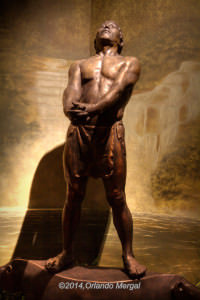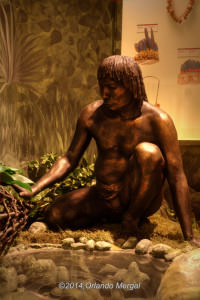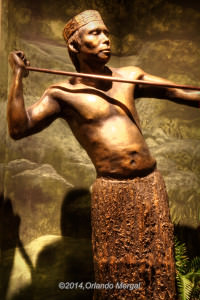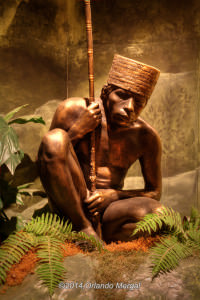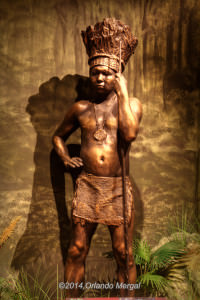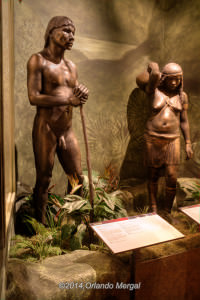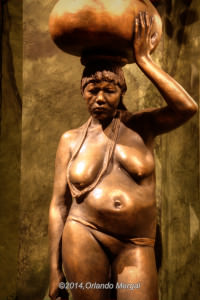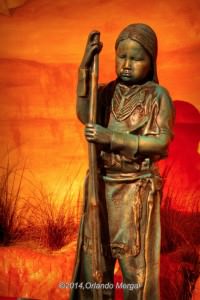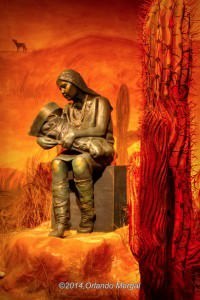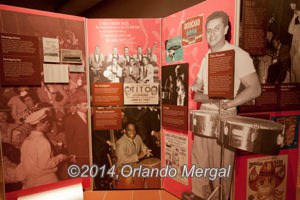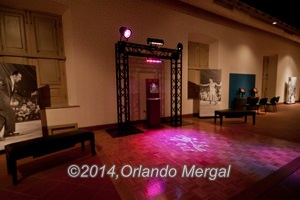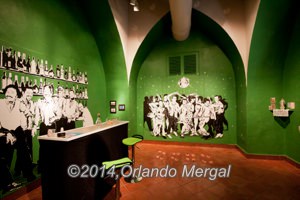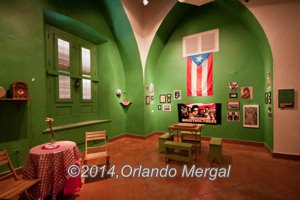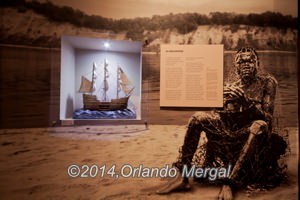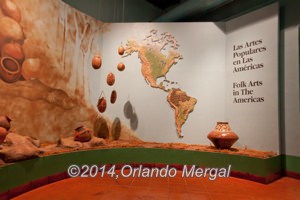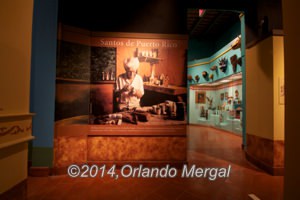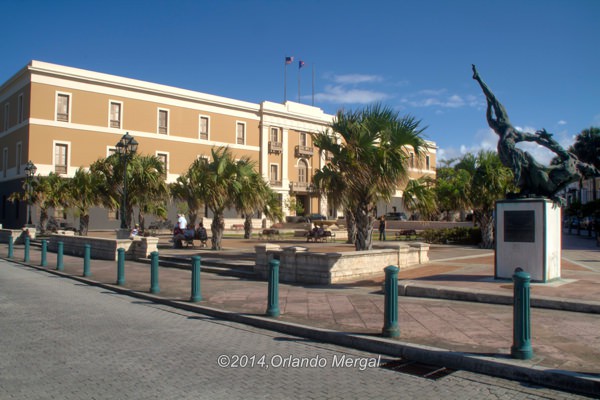
The Museum Of The Americas occupies the entire second floor of the Ballajá Military Barracks in Old San Juan
Most people that visit Puerto Rico come here because of a handful of reasons. Some come because of the beaches. Others come because of the Spanish forts in Old San Juan. Still others come because of the marvelous Puerto Rican cuisine and the tropical climate. But very few come because of our museums.
Well, let me tell you. That’s a shame, because Puerto Rico has several museums that are absolutely breathtaking.
Yesterday I visited one of those museums. The funny thing is that I had literally walked by this place hundreds of times and never took the time to check it out. Well, that was my loss.
The Museum of the Americas opened its doors in October of 1992 as an initiative of the Puerto Rican Commission for the Commemoration of the Fifth Centenary of the Discovery of America. On that occasion the Island hosted the Christopher Columbus Regatta for which tall ships from all over the world met at San Juan Harbor for two consecutive weeks.
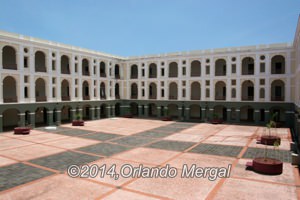
The Ballajá Military Baracks are the last and largest military building built by the Spaniards in the New World. (click to see the image larger)
Many historical buildings in Old San Juan were refurbished to celebrate the Fifth Centenary of the Discovery of America including the Ballajá Military Barracks (where the Museum of the Americas lives today), the Asilo de Beneficency (house of the poor) across the street and the Colonial Sanitarium (Manicomio Municipal) where the “Escuela de Artes Plásticas” (School of Plastic Arts) lives today.
The Quincentennial Square that sits immediately to the east of the Ballajá Military Barracks, with its majestic “Totem Telurico” on the south center side was also built for that occasion.
Well, yesterday morning, after 22 years, I finally got around to visiting the Museum of the Americas. And boy had I missed out on a great experience!!! And its a pity because, according to our guide Diana Linares, most Puerto Ricans never visit it either.
The first thing I can tell you about “El Museo De Las Américas” is that it’s huge! It takes up the entire second floor of the Ballajá Military Barracks building. And just so you know, the Ballajá Military Barracks were the last and largest military building built by the Spaniards between 1854 and 1864 in the New World. So plan to spend at least a couple of hours at the Museum of the Americas.
During our visit we had the privilege of having an excellent guide who took us through the entire museum and explained every exhibit in great detail. But this is not the norm. Most visitors explore the museum on their own unless they are part of a larger group or they have made some sort of arrangement in advance. However, there are trained guides in every hall who will gladly answer all your questions.

Ricardo Alegría
The “Museo de las Américas” was the brainchild of Don Ricardo Alegría, one of Puerto Rico’s most staunch defenders of Puerto Rican culture, and Director of the Puerto Rico Institute of Culture at the time. The entire facility is dedicated to different facets of Puerto Rican and American culture. And that includes exhibits about North, Central and South America as well as the Caribbean.
When you enter the museum you go back in time to a place where man and nature lived in unison. The first exhibit is titled “El Indio En América” (Indians In America). Its a permanent exhibit dedicated to the Island’s original Taíno Indians as well as the original ethnic groups that settled the American continents, twenty-two of which still exist and struggle to survive in a post colonial world. This exhibit was opened to the public in 2006 and it’s still one of the most popular in the museum.
There are all sorts of graphic and audiovisual exhibits in this hall but the one thing that makes it unique are the 23 hyperrealistic sculptures by Swedish-Peruvian artist Felipe Lettersten, who is fondly referred to as “Felipe el escultor” (Felipe the sculptor) among the museum’s personnel. Lettersten made it his mission in life to explore the Americas (the Amazon area mostly), find these indigenous tribes and sculpt fiberglass statues of a representative of each tribe. He succeeded in sculpting all of the tribes with the notable exception of the Jíbaro Head Hunters of Ecuador and Peru, who he avoided for obvious reasons. He also kept his promise and returned to each tribe to deliver a copy of their particular statue to the tribe’s elders. His sculptures were one of the centerpieces of the Commemoration of the Fifth Centenary of the Discovery of America.
Towards the end of this exhibit there is an excellent 30-minute documentary (available in English or Spanish) that describes Felipe Lettersten’s journey along 48 rivers and among the 22 tribes that he visited during his lifetime, how he dealt with the different native cultures, how the actual statues were made and how he kept every one of his promises with the tribe elders. Once you watch this short program you will truly understand the immense importance of this hall.
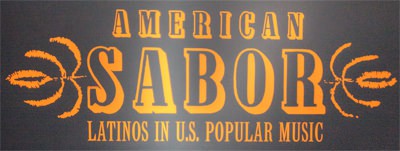
The American Sabor exhibit will be available until July 6, 2014
After leaving the “Indians In América” exhibit we entered an itinerating exhibit created by the Smithsonian Museum in Washington, DC titled “American Sabor… Latinos in US Popular Music”. Now, I’m what they call a “baby boomer”. So most of what’s on exhibition in this hall happened during my lifetime. So what can I say. I loved it!!!
There were exhibits about Israel “Cachao” López, Arturo Sandoval, Gloria Estefan, Tito Puente, Celia Cruz, Tito Rodríguez, Pérez Prado, Machito, Daddy Yankee, René Pérez “Calle 13”, Willie Colón, Héctor Lavoe, The Fania All Stars, Eddie Palmieri, Rubén Blades, Carlos Santana, Joan Báez, Sheila E., Los Tigres del Norte, Richie Valens, Linda Rondstat, Herb Alpert and the Tijuana Brass, Selena, Freddy Fender and many, many more.
Many of the exhibits had buttons which allowed you to listen to the artist and there was even a dancing floor with an actual jukebox were you could dance to your favorite tunes.
So if you like Latino music and you’re visiting San Juan before July 6, 2014 make sure to enjoy this exhibit.
Right after we left the “American Sabor” exhibit we entered a smaller hall were there’s an exhibit titled “De Barrio Obrero A La Quince”, which in English would be something like “from the worker’s neighborhood to stop 15”.
I know, for most people who are unfamiliar with Puerto Rico this will make no sense, but let’s just say that at one point in Puerto Rican history “Barrio Obrero” was a neighborhood where most people were blue collar workers and “La Quince” was where bus stop #15 was in the Santurce area. So essentially what the name does is describe an area from one point to another. It’s also the name of a popular salsa tune.
In any case, during the 50’s and 60’s this was fertile ground for musicians and singers, who would meet at “cafetines” (small cafes) in the “Barrio Obrero” and Stop 15 areas. Many of Puerto Rico’s most prolific artists got their start in this area including: Gilberto Santarosa, Ismael Rivera, Rafael Cortijo, Andy Montañez, Tommy Torres, Tite Curet Alonso, César Concepción, Carmita Jiménez, Carmen Delia Dipini, Danny Rivera, Tito Henríquez, Cano Estremera and many more.
Puerto Ricans have a unique mix of cultural backgrounds. Many words, dishes and even certain personality traits come straight from their Taíno ancestry. Their language and way of life is heavily influenced by their Spanish heritage. But, while most Puerto Ricans can be considered “mulatos” (a tan colored skin made up the mixture of Indians, Spaniards, African slaves and —yes— even American blood), when it comes to music, food and an overall love for a good party, their “African” heritage comes to the surface.
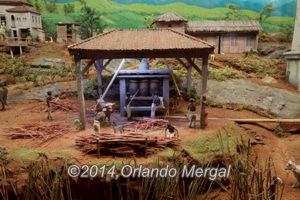
Trapiche de Sangre. “Blood Press”. Sometimes slaves would slip while pressing sugar cane and their arms would be crushed. Click on image to see it larger.
And that’s what the next hall was all about. It’s called “La Herencia Africana” (the African Heritage) . It’s a permanent exhibit that covers every aspect of how African people arrived at Puerto Rican shores, what part of Africa they came from and how they have influenced almost every aspect of daily life on the Island.
More importantly, it covers how Africa was —in fact— the cradle of humanity and how African civilization was of paramount importance for other civilizations that have brought us to what we have today.
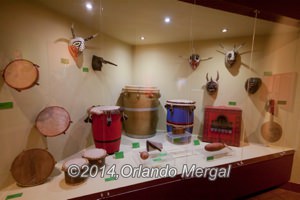
Africans influenced our literature, our music, our art, our diet, our love for dancing and many other aspects of our culture. Click on image to see it larger.
This hall has excellent exhibits about slavery on the Island, how Puerto Rican abolitionists were among the first and most vocal in America and the influence of Africans in our literature, our music, our art, our diet, our love for dancing and many other aspects of our culture.
So how did all this come to be? Well, there was once this Italian dude called Christopher Columbus that convinced the queen of Spain to finance a crazy trip to Cipango (present day Japan) that resulted in the accidental discovery of an entirely new world. Talk about getting lucky!!!
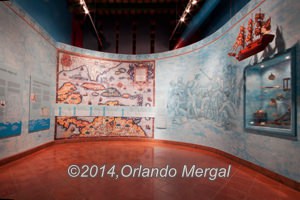
Conquista y Colonización. The story of how it all started and how we got to where we are today. Click on image to see it larger.
And that’s what’s covered in the next exhibit called “Conquista y Colonización” (conquest and colonization). This permanent exhibit covers every aspect of the Island’s 500+ years of history, from the Spanish conquistadors, their Catholicism and the emergence of Puerto Rico as one of the most important trade centers of the Caribbean, to the last 100+ years, from the American invasion in 1898 to present day Puerto Rico.
And finally we reached the last permanent exhibit, which was actually the original one when the museum opened its doors back in 1992. This hall is called “Las Artes Populares En América” (Folk Arts In The Américas). Together with the first hall (Indians In América) this is one of the favorite exhibits in the entire museum.
It covers all aspects of Puerto Rican and Latin-American culture from basket weaving, pottery, leatherwork, rustic architecture, typical garments, musical instruments and religion. It also has a unique collection of hand-carved wooden saints “santos de madera” donated by the family of museum founder Don Ricardo Alegría.
The Museum Of The Americas is open to the public Tuesdays thru Fridays, from 9:00am to 12 noon and from 1:00pm to 4:00pm. It also opens Saturdays from10:00am to 5:00pm and Sunday afternoons from12:00 noon to 5:00pm and every 3rd Thursday of the month during the nighttime for special exhibitions.
And the admission? Well, that’s the best part. You won’t break the bank. Admission to this marvel of a museum is only $6.00 for adults and $5.00 for children, senior citizens over the age of 65 and students with ID cards. For more information call: 787–724-5052 or visit their website at: http://www.museolasamericas.org.
So there’s no excuse not to spend a couple of hours in this wonderful facility and learn all about the history of Puerto Rico and its neighboring American countries.
Now, there’s one thing that I have to admit. I didn’t ask if photography is allowed. Of course, I took lots of pictures because I was covering the museum for Puerto Rico By GPS. But, of course, that doesn’t necessarily mean that anyone toting a camera would be allowed to do the same. So ask first and save yourself the hassle.
And one last thing! I shot lots of video too. So I’ll be posting a separate video on YouTube in about a week or two. I’ll let you know when that happens.
Enjoy Puerto Rico,
©2014,Orlando Mergal, MA
____________________
Bilingual Content Creator, Blogger, Podcaster,
Author, Photographer and New Media Expert
Tel. 787–750-0000, Mobile 787–306-1590
